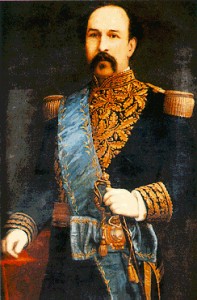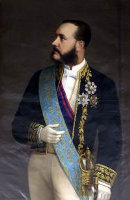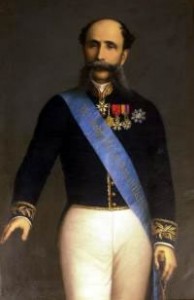Presidents of Ecuador in the two decades1 between Garcia Moreno and Eloy Alfaro (1875-1895)
President Veintimilla (1876-1883)
A year after the Assassination of Gabriel Garcia Moreno, Ignacio de Veintemilla assumed the presidency of Ecuador by coup. Initially, Veintemilla was determined to reverse the theocratic system of President Garcia Moreno with a firm, strong hand. Garcia Moreno had placed all education in Ecuador under strict Church control; Veintemilla reversed this and secularized education in February of 1877. The archbishop of Quito, José Checa y Barba, protested loudly against this declaring that he “would oppose with all his strength the propagation of error in his diocese.” But Veintimilla would have none of it; two weeks later the archbishop was poisoned on Good Friday – by means of strychnine added to the wine used for Mass (March 30th). Veintemilla even went so far as have a government order issued calling for a funeral service in memory of the soldiers who had fallen in the coup which had brought him to power (“victims of their devotion to liberty and their hatred of tyrants.”). The highly pro-Catholic Author P.A. Berthe recounts a subsequent series of events in which Vientimilla attempted to relentlessly subdue the pro-Catholic faction in Ecuador.
Then in June of 1877 he renounced the Concordat with the Pope that had been such a central part of Garcia Moreno’s system of government. One of the Bishops (Bishop of Riobamba) pronounced a sentence of excommunication against anyone who obeyed Veintimilla’s renunciation of the concordat. Other bishops spoke out in protest; some were exiled; there were popular uprisings against Veintimilla. Eventually Vientimilla realized that the political cost of his attempted reforms rendered the plan unsustainable. By 1882 he had reversed course completely;
…he solemnly received the Apostolic Nuncio, to whom he declared that his only anxiety was to preserve and even draw closer the links which bound the nation to the Holy See. As a proof of his sincerity he restored the Concordat and appointed his old enemy, [Bishop of]Riobamba, as archbishop of Quito.
–from “Garcia Moreno President of Ecuador” by Rev. P. A. Berthe
Ultimately Veintimilla was opposed by both “liberals” and “conservatives”. R. Perez Pimentel describes him as “well-built, well-loved and fun …made many friends”; however he appears to have cared little for religion. Ecuadorian opinion could not be persuaded to abandon the “Republica Catolica” for such a man.
Dr. Martinez
During the presidency of Veintimilla Dr. Martinez -recently returned from Pennsylvania with his newly-minted American Medical Degree- was establishing himself as a surgeon and member of the Medical Faculty at the new Medical School at Central University in Guayaquil. During this time he also married his first wife Rafaela Serrano y Ruiz and they started a family. Most of the drama of the back-and-forth contest between Veintimilla and the Church (such as the secularization of education and the revolt by the clergy and the populace that resulted, which directly affected Central University where he taught) took place in Quito so Dr. Martinez and his wife were undoubtedly close witnesses to it; but he was busy with his medical profession at this time.
Eloy Alfaro
Toward the close of Veintimilla’s presidency, Eloy Alfaro was leading military campaigns and at one point he proclaimed himself “Jefe Supremo” of Manabi and Esmeraldas provinces (northwest province). In the end Alfaro was powerful enough to besiege Guayaquil and force Veintimilla from the presidency but Alfaro’s movement was not powerful enough to seize the presidency (ie: to install Alfaro himself as the new president) at this time.
President Caamaño (1883-1888)
When Jose Maria Caamaño assumed the presidency he was viewed by the pro-Catholic faction as their candidate of choice for permanently re-imposing a “Republica Catolica” on all of Ecuador. Many years before, President Garcia Moreno had named him as the right man to succeed him as he had “…all the essential qualities of a statesman one whose honour was without a stain, with good sense and a strong religious spirit, being among the number of those who at Guayaquil had never hesitated to practice his duties as a Christian…”2. Acclaimed as “Conservative and Catholic, devoted to the Church…”, he is reported to have gone so far as to request from Garcia Moreno’s widow the scarf of her late husband so that he could wear it while taking his oath of office.
Then, in June of 1886 he presided over an opulent religious ceremony (“Eucharistic Congress”) in Quito to mark the thirteen-year anniversary of the dedication of the Republic of Ecuador to “The Sacred Heart of Jesus” which had originally occurred under Garcia Moreno in 1873. Apart from the details of the ceremony itself, this dedication was intensely symbolic of a complete re-immersion and re-imposition of the theocratic “Republica Catolica” system in Ecuador. Author Peter Henderson provides an excellent explanation of its symbolism in relation to Garcia Moreno. Now President Caamaño was fully intending to send the same message that his slain predecessor had sent thirteen years before.
“…no measure did more to incur the wrath of liberals or create the image of Garcia Moreno as a fanatic than his decision to dedicate Ecuador to the Sacred Heart of Jesus in 1873. Part of Catholic Doctrine from around 1000 A.D., the Sacred Heart referred to Jesus’ physical heart, the symbol of his redemptive love. Pope Pius IX encouraged families, communities, and nations to consecrate themselves to the Sacred Heart, and a number did. In the nineteenth century the cult symbolized the rejection of liberalism because Louis XVI of France had promised to dedicate France to the advocation, had he escaped the guillotine. Hence the Sacred Heart found many followers among conservatives of late nineteenth-century France… Ecuador’s statute ordered that a shrine to the cult be built in each cathedral in the country and that a special Mass occur at the cathedral in Quito to commemorate the dedication.”
–from Peter Henderson, “Gabriel Garcia Moreno and conservative state formation in the Andes” (U.T. Press 2008)
But it wouldn’t be sufficient to simply re-enact the dedication of Ecuador; no, the young son and the widow of the slain Garcia Moreno who had first instituted the “Republica Catolica” were given a central role in the ceremony. The whole city of Quito was “hung with black” and funeral orations were read for the great departed hero Gabriel Garcia Moreno. The ceremony included a “Litany of Reparation” in which the “Pardon! Pardon!” of God was implored for “the shameful excesses of the Press”, “attacks against ecclesiastical authority”, “impieties and blasphemies” …etc…etc. The message was clear! A lengthy description of the whole ceremony appeared in a book published in 1889. Click the “expand” link below to read this lengthy description.
Excerpt on the re-dedication of Ecuador under Caamaño
(from the 1889 biography of Gabriel Garcia Moreno by A. Berthe):
“The Honourable Jose Maria Caamano, one of the leading men of the Conservative party, had been elected President a year before the tenth anniversary of the terrible drama at Quito [ie: the murder of Garcia Moreno], and he determined on a solemn glorification of the Christian hero whom the miserable tyrants of the preceeding years had so wontonly insulted.
On the 6th of August, the whole city being hung with black, a magnificent service was held in the Cathedral in the presence of all the Bishops, the President, and the civil and military dignitaries. All eyes turned lovingly to the young Gabriel, then fifteen years of age, who for the first time publicly led the mourning for his noble father. Around him were grouped the widow and relations of Garcia Moreno, the circle of ” young Catholics,” which he had established, the nobility of Quito, and an innumerable number of people of all ranks. The Apostolic Nuncio officiated amidst the tears of the assistants, and a beautiful funeral oration was pronounced by F. Proano, S.J., in which he dwelt on his noble nature, his admirable character, and the signal benefits he had conferred on his country, winding up with the words : ” His murderers declared that August 6, 1875, would open out to the country a new era of peace and prosperity; that the death of the Ecuador Colossus would give a fresh start to civilization and progress. Fools ! how have they kept their promises ? . . . Et nunc, reges, intelligite ! ”
The new President was worthy to listen to these great lessons : Conservative and Catholic, devoted to the Church and to the people, he did not understand a policy which made a pact with Revolution. It is said that the day when he was to swear on the Gospels not to undertake anything against the Catholic Church, he went to see the widow of Garcia Moreno and asked her to lend him the .-scarf of her illustrious and noble husband. ” I hold,” he said, “to people looking upon me as the humble successor of his glorious and loyal policy.” ” I will not lend it, but give it to you,’ replied that noble-minded lady. ” No one is more worthy to wear it than yourself.”
On June 21, 1886, a great Eucharistic Congress was held in Quito to celebrate the second centenary of the public worship of the Church to the Sacred Heart. The Chambers were closed on that day ; so that the whole of the deputies, with the President at their head, should celebrate this national fete. At sunrise, salvos of artillery woke the whole city. At seven o’clock the whole of the churches were rilled with men and women of every rank to receive Holy Communion. In the Cathedral alone, ten thousand souls received the Bread of Life. Then followed .a solemn Act of Faith and Reparation, pronounced by the Archbishop in presence of all the civil, military, and ecclesiastical authorities. It ran as follows :
” King of kings ! and Lord of lords ! on Whom alone depend all the empires and nations of the earth, in gratitude for Thy great mercies, the public authorities of Church and State, prostrated at Thy feet, offer to Thy Divine Heart, and conse- crate to It for ever, the Republic of Ecuador. Deign to accept this people as Thy heritage, to reign over them for ever, to deliver them from their enemies, and to show to the whole world the happiness enjoyed by a nation which has chosen Thee for its Saviour and its God.”
Then began, amidst the tears of the assistants, the Act of Expiation and Reparation for all the offences committed against the Divine Majesty. ” Lord and God, our Creator and Master, by Whom alone all kings reign and legislators rule the nations of the world, to Thee are due solemn acts of praise and thanksgiving for having defended us from our enemies and overwhelmed us with Thy gifts. But alas ! instead of corresponding with Thy goodness, we have sinned against Thee, we have trodden under foot Thy Divine Laws, and deserved all Thy chastisements. Look not upon our iniquities, O Lord ! but only upon Thy mercy.”
Then followed the Litany of Reparation, the responses being said by the whole people.
” For all our iniquities.”
” Pardon us, good Lord.”
” For the sins of Thy priests.”
” Pardon ! pardon ! ”
” For the injustices of our rulers,
” For the faults of our magistrates,
” For the sins of fathers of families,
” For the crimes of unworthy men,
” For their impieties and blasphemies,
” For their perjuries and sacrileges,
” For our Revolutions and fratricidal wars,
” For the attacks against ecclesiastical authority,
” For the plots against civil authority,
” For the horrible crimes of the 6th of August and 3Oth of March,
” For the shameful excesses of the Press,
” For our political crimes,
” For our public scandals,
” In a word, for all our social iniquities,”
” Pardon us, good Lord ! pardon us!” cried the whole immense multitude as with one voice.A few days after this act of public expiation, the feast of the Sacred Heart re-united again all the ecclesiastical and civil authorities, who, with the President at their head, consecrated themselves, one by one, anew to the Sacred Heart. Their example was followed by the whole city, and until the end of that great day, soldiers, judges, fathers and mothers of families, young men, and children filled the great Basilica, renewing one by one their act of consecration. This scene, worthy of the heroic ages of faith proved that the work of Garcia Moreno had not died with him. “
from Berthe, “Garcia Moreno President of Ecuador” (pub. 1889) p.327ff
Dr. Martinez Enters the Arena – and is exiled for it
It was in the early period of Caamaño’s Presidency – in late 1885 – that Dr. Martinez first started to speak out publicly in his weekly publication El Perico (“The Parakeet”). In this publication, Caamaño is not mentioned – nor is any identifiable individual singled out for criticism. Instead the authors are birds or pseudonyms; and concepts rather than individuals are attacked. In some cases metaphorical individuals are created in the text and these are attacked.
The first issue of El Perico was published on November 7th 1885. By early February, a mere three months later, the government had shut down publication. Under threat of imprisonment3, Dr. Martinez was allowed to go into exile to Peru. At that time he was married to his first wife Rafaela Serrano y Ruiz and the couple had several small children. He was a highly respected physician and a University Professor at the Medical School of Central University in Quito; Ecuador’s largest university and one of the oldest in the Americas. He undoubtedly had no way of knowing how long his exile would be. In fact it would last three years until Caamaño’s successor came to power, President Antonio Flores Jijón.
Ultimate fate of President Caamaño (1883-1888)
President Caamaño’s term of office ended in 1888 at which time he exited the Presidency, passing power peacefully to his duly elected successor. By the mid 1890’s he was governor of the province of Guayas. But in 1895 he became involved in a complex transaction that would have grave consequences for himself and for the country. The government of Chile wanted to sell (ie for profit) a battleship to the government of Japan but they could not legally do so due to the fact that they had officially declared themselves to be neutral in the Sino-Japanese War. Due to the fact that Caamaño had close ties to Chile and to Ecuador’s Chilean Ambassador, he became aware of this intention of the Chilean government and agreed to act as an intermediary in the transaction to make it appear as if Ecuador had bought the ship from Chile and then sold it to Japan. But ultimately the scheme was uncovered; it became known as the “Esmeralda Affair” or “Sale of the Flag” (“venta de la bandera”). Cordero, the president in 1895, claimed ignorance of the whole affair and Caamaño openly confessed his complicity but ultimately the Ecuadorian courts upheld the illegality of the matter, the opposition was strong; the president resigned and Caamaño departed Ecuador forever. His circumstances left him impoverished and he lived out the remainder of his life in Seville Spain and died there in poverty on December 31st of 1901 (or 1900 according to another account) – a mere five years after his departure.
President Antonio Flores Jijón (1888-1892)
President Antonio Flores was the son of General Juan Jose Flores who had served as President of the Republic of Ecuador at its inception in the 1830’s. Biographer Rodolpho Perez Pimentel mentions that in 1877 when president Veintimilla was attempting to undo the programs of Garcia Moreno, Antonio Flores’ home had been raided and “he was imprisoned by order of President Veintimilla due to ‘links with conservative elements’ ” …but that after a few days he managed to escape and that by January 1878 he was living in New York with his daughters.
Later during the presidency of Caamaño he was appointed minister plenipotentiary in Europe to the Vatican. Garcia Moreno’s fawning biographer recounts how Flores presented the Pope (Leo XIII) with a gift of “a precious casket of crystal de roche, ornamented with precious stones” containing an autographed message which president Garcia Moreno had borne in his hands on the day of his murder and that was “stained with his heroic blood” But when he became president in 1888 he wasted no time in granting amnesty to the exiles, allowing them to return to Ecuador without danger of prosecution. One of these exiles was Dr. Martinez who had been exiled by Flores’ intensely pro-Catholic predecessor, Caamaño three years previously in February 1886. R. Perez Pimentel remarks that in the United States, Flores had “learned what democracy was.”
Antonio Flores Jijon is also noted for having formed the somewhat short-lived “Progressive” party in Ecuador and he was the first president allied with that party. The Progressive Party (originally known as the “Republican Union”) was a response from the pro-Catholic or conservative side intended to break the old conservative/liberal stalemate and reconcile the interests of the coastal constituency (centered in Guayaquil) with the mountain constituency (centered in Quito) in a new alliance. But it was not destined to last. The great revolution of Alfaro three years after Flores’ presidency ended would bring profound changes to the political landscape of Ecuador.







